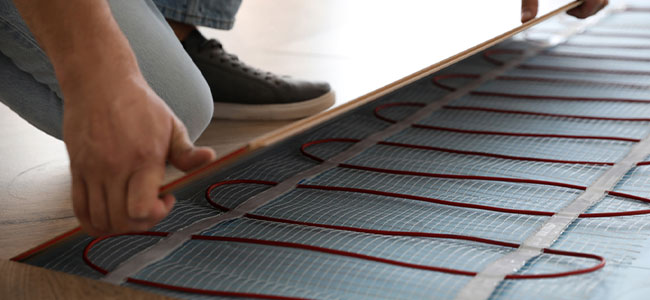
Exploring the Pros and Cons of Underfloor Heating
Depending on your specific needs, underfloor heating could be a worthwhile and far more sustainable option.
- By James Ritter
- Oct 06, 2023
Have you ever considered how an underfloor heating system could transform your home or business? Rather than relying on a radiator turned up to full heat for a couple of hours, an underfloor system runs for a longer period of time but at a lower temperature, taking the edge off the chill in the air. While it doesn’t provide the blast of hot air that radiators do, it can help the internal temperature feel more stable and comfortable overall.
It sounds good, and in the right setting, it can be. However, it is important to understand both the pros and cons of underfloor heating before committing to this method of warming your home or business. Let’s explore whether underfloor heating might be right for your situation.
Pros
Increased energy efficiency.
One of the biggest pros of underfloor heating is that it is more efficient than a traditional heating system. In fact, water-based underfloor heating systems can be around 25 percent more efficient than radiators, with this statistic jumping up to 40 percent when paired with a heat pump. Not only is this good for your electricity bills, but it’s also beneficial for the planet, reducing the amount of carbon dioxide released into the atmosphere and contributing to global warming.
Integrates well with heat pumps.
Heat pumps are notoriously energy efficient, achieving around 300 percent efficiency on average. This means for every unit of energy they take in, they output three units of energy into your property. In comparison, an A-rated gas boiler will be around 95 percent efficient.
With a nationwide push for homeowners to consider cleaner energy sources in their properties more generally, heat pumps may well be the future. If you’re thinking about moving to this new technology, then upgrading your heating system may be the way to go, rather than paying out for new radiators only to replace them with underfloor heating at a later date.
Removes the need for radiators.
Aesthetically, radiators are a large part of any room. Their placement on the walls can draw the eye away from any carefully curated interior design statements, and they can also take up valuable storage space. In contrast, underfloor heating systems are, as the name suggests, hidden under your flooring. This may also be reassuring if there are young children around, who may be tempted to touch the hot radiators. Even if they are unlikely to be too hot for adults, they may be a bit too warm for little hands.
Cons
Cost.
Perhaps the main issue with getting underfloor heating installed is the cost. While they will generate cost savings in the long term, there are often higher upfront costs associated with this system. This is because the parts are more complex, and the installation process takes longer.
In some cases, electric underfloor heating can be bought in mat format and installed by a competent DIY renovator. However, water systems should always be installed by a professional, due to the complexity of the parts and the high risk of flooding if something isn’t connected correctly.
Impact on flooring material.
Adding radiators to a wall or upgrading your existing ones can cause some mess, but installing underfloor heating requires taking up existing flooring in order to lay the pipes and cables. In addition, the floor level may need to be raised in some cases to make room for the pipes if they can’t be sunk into the base material. This can be highly disruptive, especially if you’re planning to install this heating system throughout your home or business.
If something goes wrong with the system, modern technology can be used to locate the point of the fault without having to lift all the floorboards, but engineers will need to lift at least a small section to get to the pipe. Although underfloor systems are usually highly reliable, there is no guarantee that something won’t go wrong over the lifetime of the product.
Better for your bills and the planet but an upfront cost
Ultimately, underfloor heating systems can be a great choice, especially if you’re looking to increase the sustainability of your property and reduce heating bills. However, there’s no denying that there is a large upfront cost to pay. So consider this carefully when making a decision about whether it’s right for you.
About the Author
James Ritter is a digital consultant with a particular interest in sustainability and has advocated for content focussing on both local and global environmental issues. James majored in creative writing at university and is always eager to expand his knowledge around different subjects.